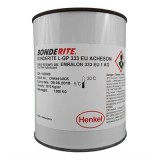
Surface Preparation
Substrates must be dry and free of contaminants (dirt, grease, powder, and other
residues)before application of Emralon 333. Excellent results can be obtained without pretreatment.However,
for maximum wear characteristics the following pre-treatment’s are
recommended:heat stable phosphate coating* or grit blasting for steel; grit blasting or heat
stable conversioncoating for aluminum.
Mixing
Emralon 333 is supplied ready for use, but it should be mixed thoroughly by stirring. For
bestresults, use a low speed propeller-type mixer. Do not vortex or agitate violently, as
airentrapment or foaming may cause separation of solids.
Application
Emralon 333 is normally applied by spray techniques. An external atomizing type gun
usingan MBC #30 nozzle is recommended. Optimum coating thickness is 0.001 inch
(25.4microns). USE ONLY SB-3 SOLVENT FOR CLEAN-UP. Incompatible solvents will
cause gunblockage. Emralon 333can be overcoated for repair purposes without removing
the entireoriginal film. Sand lightly or use steel wool to feather the edges of the area to be
repaired.Light abrasion of the surrounding areas is also recommended for maximum
adhesion. Thenapply Emralon 333, using the same spray procedures as for the initial
application. Follow thestandard cure cycle as stated below.
Curing
Emralon 333 may be cured by exposure to any of the time/temperature conditions
indicated inthe following table. It is essential that the high boiling solvents in Emralon
333be removedgradually before the cure is completed or the coating will be marred by
blisters. Gradualremoval of the solvent can be accomplished by preheating the coating for
ten minutes at149°C (300°F) or 177°C (350°F) before curing.
For example, typical cure cycles are:
SUBSTRATE TEMP/TIME SUBSTRATE TEMP/TIME
(a) 149°C (300°F) 10 min.
(b) 149°C (300°F) 10 min.
(c) 149°C (300°F) 10 min.
(d) 177°C (350°F) 10 min.
(e) 177°C (350°F) 10 min.
260°C (500°F)/ 15 min.
288°C (550°F)/ 9 min.
316°C (600°F)/ 5 min.
371°C (700°F)/ 1 min.
399°C (750°F)/ ½ min.